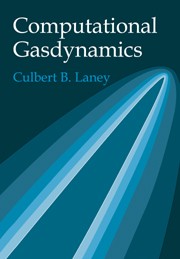Book contents
- Frontmatter
- Contents
- Preface
- Chapter 1 Introduction
- Part I Gasdynamics Review
- Part II Computational Review
- Chapter 6 Numerical Error
- Chapter 7 Orthogonal Functions
- Chapter 8 Interpolation
- Chapter 9 Piecewise-Polynomial Reconstruction
- Chapter 10 Numerical Calculus
- Part III Basic Principles of Computational Gasdynamics
- Part IV Basic Methods of Computational Gasdynamics
- Part V Advanced Methods of Computational Gasdynamics
- Index
Chapter 6 - Numerical Error
Published online by Cambridge University Press: 07 December 2009
- Frontmatter
- Contents
- Preface
- Chapter 1 Introduction
- Part I Gasdynamics Review
- Part II Computational Review
- Chapter 6 Numerical Error
- Chapter 7 Orthogonal Functions
- Chapter 8 Interpolation
- Chapter 9 Piecewise-Polynomial Reconstruction
- Chapter 10 Numerical Calculus
- Part III Basic Principles of Computational Gasdynamics
- Part IV Basic Methods of Computational Gasdynamics
- Part V Advanced Methods of Computational Gasdynamics
- Index
Summary
Introduction
In the problems of interest to us, the solution is either a vector or a function. How can we measure the error of approximations to such solutions? One approach is to measure the error in each component of the vector or in each value of the function. Then the error is itself a vector or a function. However, such error vectors and functions provide a wealth of useless information, and may actually obscure critical evaluation. Thus, for most purposes, we prefer a single number measuring the overall size of the error. Such a measure is called a vector or functional norm.
After discussing error norms, this chapter describes the two basic categories of numerical errors: round-off errors and discretization errors. Round-off errors are any errors caused by the use of finite-precision real numbers, rather than the true infinite-precision real numbers. Discretization errors are any errors caused by using a finite-dimensional vector rather than the true infinite-dimensional vector, or a finite sequence rather than the true infinite sequence, or a finite series rather than the true infinite series, or a finite sequence or series such as a truncated Taylor series rather than the true function.
Norms and Inner Products
This section concerns vector and functional norms and inner products. Consider a scalar x. The absolute value |x| measures the size of x. Recall that the absolute value has the following properties:
The last property is sometimes called the triangle inequality.
Consider a vector x. The norm ∥x∥ measures the size of x. More specifically, ∥x∥ is any scalar function of x such that
Vector norms are the natural extensions of absolute value to vectors.
Information
- Type
- Chapter
- Information
- Computational Gasdynamics , pp. 105 - 116Publisher: Cambridge University PressPrint publication year: 1998
